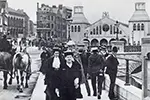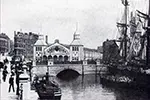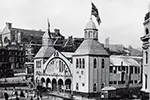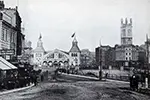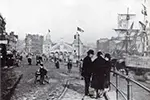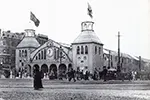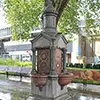This page was written because of emails I received from Allan Wathan and Hugh Watkins who both wanted information about the 1893 Industrial and Fine Arts Exhibition. Strangely enough information about the exhibition is hard to come by, I'd appreciate it if anyone who knows anything more about it would email me at
The first mention of the exhibition in the Annals of Bristol 1887-1900 by John Latimer was in the council meeting of February 14, 1983, which ended very sadly.
A melancholy incident occurred at a meeting of the Council on February 14th , 1893. After the adoption of a report of the Finance Committee recommending the construction of some improvement works at Portishead, in concert with Sir J. D. Weston, Sir Charles Wathen moved that the open space that had just been formed by covering over that part of the Float lying east of the fixed bridge should be granted until March, 1894, to the promoters of a proposed Industrial Exhibition (Mr. J. W. Arrowsmith, Mr. E. G. Clarke, and others) as a site for the undertaking. During the discussion of the resolution Sir Charles was suddenly seized with apoplexy, and expired in a few minutes. The Council immediately adjourned. The funeral service of the lamented gentleman-whose ability, liberality and hospitality during his six years' tenure of the civic chair had won him the respect of all classes-was held in the Mayor's Chapel on February 18th, after which the body was conveyed to Arno's Vale, followed by the members of the Council, the magistrates, and an unprecedented number of private carriages . [The above resolution moved by the deceased was adopted at asubsequent meeting of the Council.]
The exhibition was held in a specially built wooden hall, designed by E. S. Sinnott of Clifton, at the bottom of Colston Avenue near St. Augustine's Parade and the newly completed St. Augustine's Bridge. The hall was 110 feet wide and 520 feet long and cost £11,000 of a total cost for the exhibition of £100,000. It was lit by 20 electric and 400 gas lamps. The hall featured the first electric clock in Bristol. The electricity was produced by the new generating station at Temple Back.
The Annals of Bristol 1887-1900 says that:
The first use which was found for the covered water space between the Stone Bridge and the abolished Drawbridge was to erect upon it a vast wooden building in which to hold a "Bristol Industrial Exhibition". A guarantee fund having been subscribed, operations for its construction were begun in the spring, and the structure, 520 feet in length and 110 in breadth, was rapidly completed at a cost of £11,000. The city electrical works were made available for illuminating the building, there being 20 arc lamps of 1,000 candle- power and nearly 400 incandescent lamps. The southern section, 360 feet long, was devoted to mechanical and industrial exhibits, and the northern, of 160 feet, to a fine collection of pictures, china, and works of art, chiefly arranged in the galleries, 25 feet wide, which extended throughout the building. The exhibition was opened on August 28th by the Mayor, accompanied by a crowd of leading citizens, and the mayors of several of the neighbouring boroughs, who met at a luncheon given at the Royal Hotel, and afterwards repaired in procession to the building, the contents of which excited general admiration. The admission fee on this occasion was 5/- [5 shillings], but the ordinary charge was 1/- [1 shilling], and on one or two evenings a week sixpence. The musical entertainments by first-class military bands proved a great attraction. The exhibition closed on January 31st, 1894, having been attended by upwards of 510,000 persons, excluding holders of season tickets. The total receipts amounted to £24,484. The sale of the building material realised £1,830. After the payment of all expenses, a net balance remained of £2,271, which was divided amongst the principal medical charities.
The exhibition itself was heavily promoted by James W. Arrowsmith who owned Arrowsmith's the printers and publishers. It was opened by the Mayor, Mr. (later Sir) R. H. Symes. The exhibition made a profit of just over £2,200 which was donated to local charities. Around half a million people visited the exhibition during the five months, from August 28th 1893 to January 31st, 1894, it was open. The only trace of the exhibition now is a fountain by the Colston statue.
Various images of the exterior of the Bristol 1893 Industrial & Fine Arts Exhibition.
These come from Reece Winstone's "Bristol in the 1890's" and "Bristol As It Was 1845 - 1900"
The image of the fountain comes from List of Public Art in Bristol (Wikipedia)
Exhibits
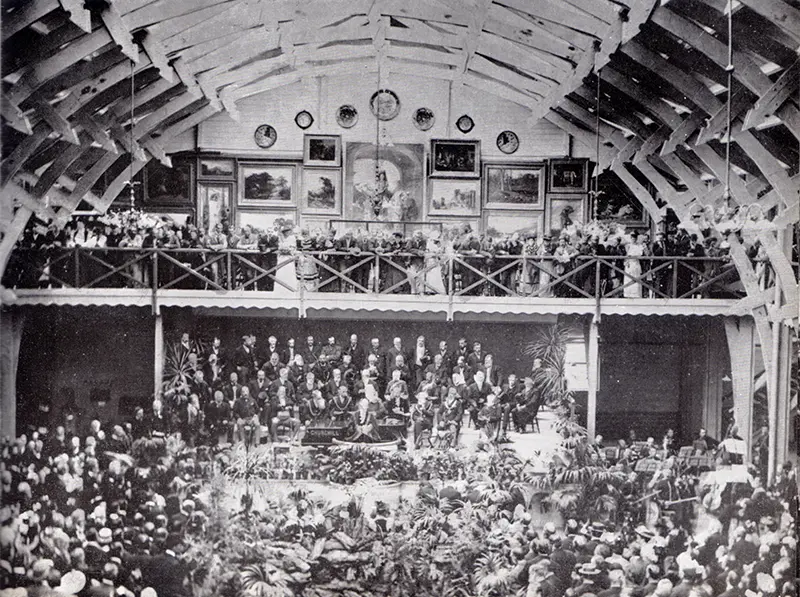
The Mayor, Mr. (later Sir) R. H. Symes opening of the Bristol 1893 Industrial & Fine Arts Exhibition
(Image from Reece Winstone's "Bristol in the 1890's")
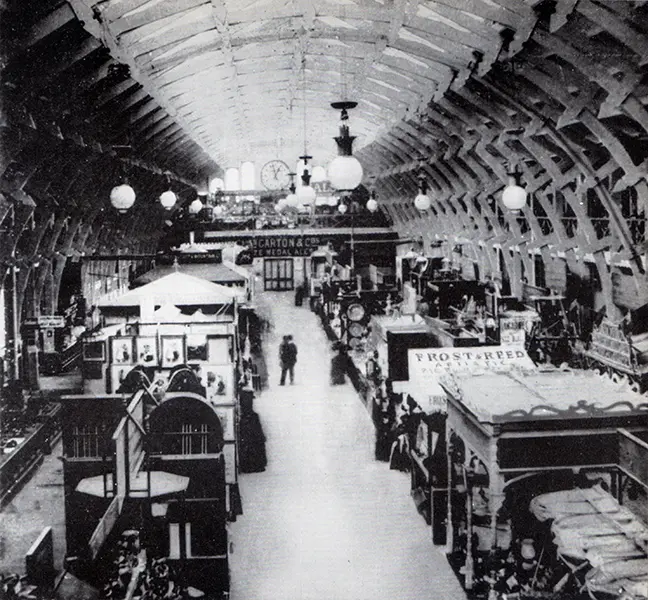
Some of the exhibits at the 1893 Bristol Industrial and Fine Arts Exhibition
(Image from Reece Winstone's "Bristol in the 1890's")
In the above photo can be seen the stand for Frost & Reed. These wre art dealers and was founded by William Hill in Bristol in 1808. Over fifty years later in 1859, the business was sold to John Frost who listed his activities as a 'Carver, Gilder, Print Seller, Wholesale and Retail Artists Colourman and Drawing Paper Depot.' Frost was the holder of Queen Victoria’s Royal Warrant as Carver & Guilder to Her Majesty. After Frost’s demise in 1875, his position was taken by his nephew Walter Frost and his new partner William Reed and in 1881 the name of Frost & Reed formally came into being. The company originally dealt in prints, mezzotints, etching and engravings and in 1908 they decided to opening a store in St. James, London. The company is still in existence with offices worldwide.
The exhibits were eclectic and the presentation of them has been likened to a "jumble sale meets reclamation yard"
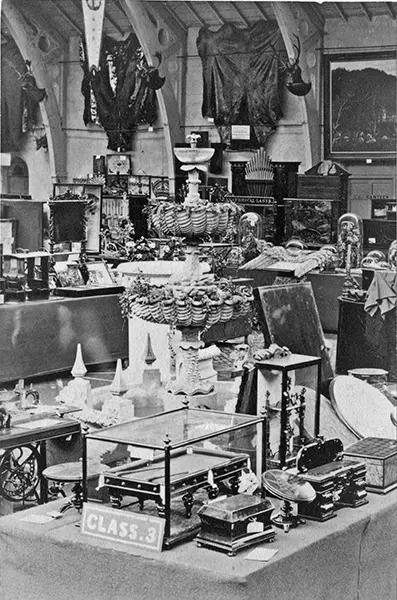
Some of the exhibits at the 1893 Bristol Industrial and Fine Arts Exhibition
Miniature snooker tables, taxidermy, an organ, paintings, and cured skins surround a centrepiece pottery fountain (Know Your Place, Bristol)
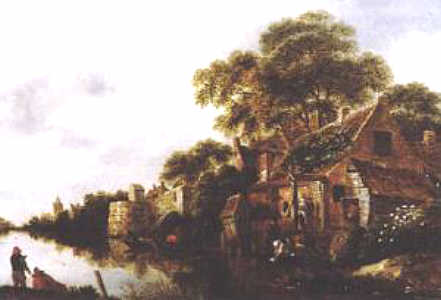
"Lavandière en bord de rivière" by Dutch artist Klaes Molenaer (1630-1676)
One of the paintings on show at the exhibition
The exhibition's main organizer and promoter, printer and publisher James Arrowsmith lent 20 paintings by William James Müller (1812–1845) to be shown. Other paintings from artists such as Sir Joshua Reynolds, and Copley Fielding were also on display.
Since his death Frederick Mockler had collected Dr. Edward Jenner memorabilia. Dr. Jenner (1749 – 1823) pioneered the concept of vaccines and created the first smallpox vaccine. Mockler made the collection available for viewing at the exhibition and for a penny, patrons could purchase a pamphlet about Dr. Jenner and the collection.
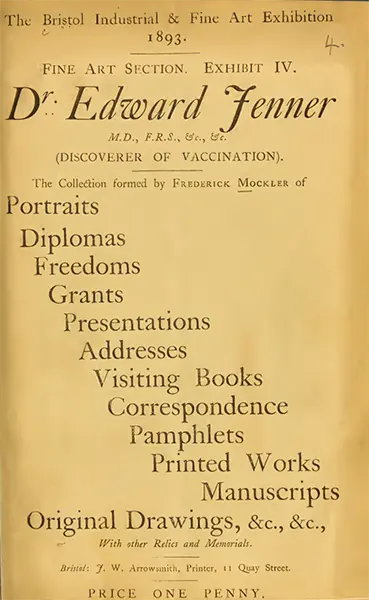
The pamphlet cover describing Dr. Jenner's collection
The pamphlet can be viewed on the Internet Archive or here (PDF, 988Kb).
Stand 160 at the exhibition was where visitors could view work done by the Clifton School of Art Needlework. E. C. Gibbons, Designer, Ecclesiastical, Heraldic and Decorative Embroiderer, 88, The Triangle, Queen's Road, Clifton.
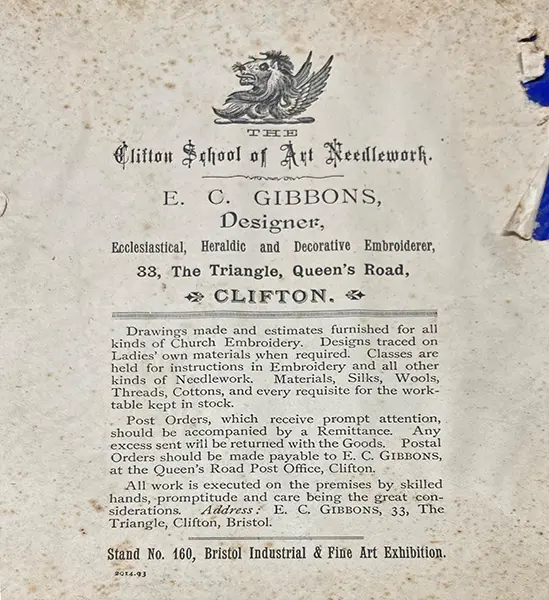
Flyer for the Clifton School of Art Needlework
Many thanks to David Wright for the image.
The text on the flyer reads:
Drawings and estimates furnished for all kinds of Church Embroidery. Designs traced on Ladies' own materials when required. Classes are held for instructions in Embroidery and all other kinds of Needlework. Materials, Silks, Wools, Threads, Cottons, and every requisite for the worktable kept in stock.
Post Orders, which receive prompt attention, should be accompanied by a Remittance. Any excess sent will be returned with the Goods. Postal Orders should be made payable to E. C. GIBBONS, at the Queen's Road Post Office, Clifton.
All work is executed on the premises by skilled hands, promptitude and care being the great considerations. Address: E. C. GIBBONS, 33, The Triangle, Clifton, Bristol.
Stand No. 160, Bristol Industrial & Fine Art Exhibition.
Industry was well represented. This article appeared in The World's Paper Trade Review (Internet Archive) of July-December, 1893:
It may fairly be said of this Exhibition that it fulfils the purpose for which it was projected, viz., to illustrate the arts and cratts of Bristol in a thoroughly representative manner, and in operation :
Messrs. Strachan and Henshaw, of Bristol, contractors for the Exhibition shafting, exhibit at No. 37, and in motion, a machine for making and printing triangular bags, which does its work well. The "Satchel" paper bag machine at Messrs. Robinson's is also from the works of these engineers. Cutting machinery is also on show by them.
Messrs. Douglas Bros., at stand No. 120, of Kingswood Hill, Bristol, show machines and cutters for label cutting, also for punching and for eyeletting.
Allen Daviws and Co. For a collection of high class machinery, as used in the different departments of Messrs. Allen, Davies and Co., Bristol (printer*, stationers, and accounnt book manufacturers, &c.), — exhibit No. 20 — there could scarcely be gathered one more thoroughly up-to-date and serviceable than that shown here. The "Wytors" cylinder letterpress, the "Wharfedale" printing machine, and the new patent "Victoria" folding machines, by R. Cundall and Sons; a Crossland "Advance" paper cutting machine; Smythe book-sewing with thread, as well as a wire stitching machine; Gough's patent automatic relief colour stamping press, and Strong's newest pattern label puncher complete the array. Our readers will admit that the firm which will provide itself with such excellent servants can turn out the best work, and of that there is ample evidence in the specimens shown. Messrs. Allen, Davies and Co. have acquired the concession for the catalogue. Their "Files" and "Tallies"" are well in evidence.
An Oil Motor is shown at exhibit No 26. The Daimler Motor Syndicate, Lim., 49, Leadenhall-street, London, E.C., have a striking exhibit here with their motor launch, actuated by a Daimler Petrol Motor. But our attention was mostly directed to the stationary motor also on show but not working. The principle of this invention is in the application of petroleum instead of water or gas, as the motive agent. The oil is "vaporised," and this actuates the engine.
James Spicer and Sons are represented by a show case, exhibit No. 206. In papers for all the various purposes required by the stationer, the printer, the lithographer and fancy box maker, Messrs. James Spicer and Sons show judicious selection.
Entertainment
The music concerts held at the exhibition were very popular. Aside from the military bands, popular artists also performed.
Beatrice Pettit (1872-1922), a cornet soloist, was one of many accomplished female brass musicians at the time. She started to perform at the age of 15, and her first appearance in public was in November 1888. She went on to study at the Guildhall School of Music, and became a soloist on cornet with a number of orchestras, bands and entertainment troupes over the years. She was also accomplished as a pianist and soprano vocalist. She was particularly associated with Rosabel Watson's Æolian Ladies' Orchestra, the English Ladies' Orchestral Society, and Eleanor Clauson's Ladies' Pompadour Band. The Ladies' Pompadour Band played at least twice at the exhibition, on Monday, September 5th 1893 when they performed The Death of Nelson and on Friday, November 24th 1893, when they played The Lost Chord.
Amateurs were given their chance to shine as well. The Musical Times of October 1, 1893 (Internet Archive), carried the following advertisement for bands, pianists, and choirs to take part in competitions at the exhibition in December.
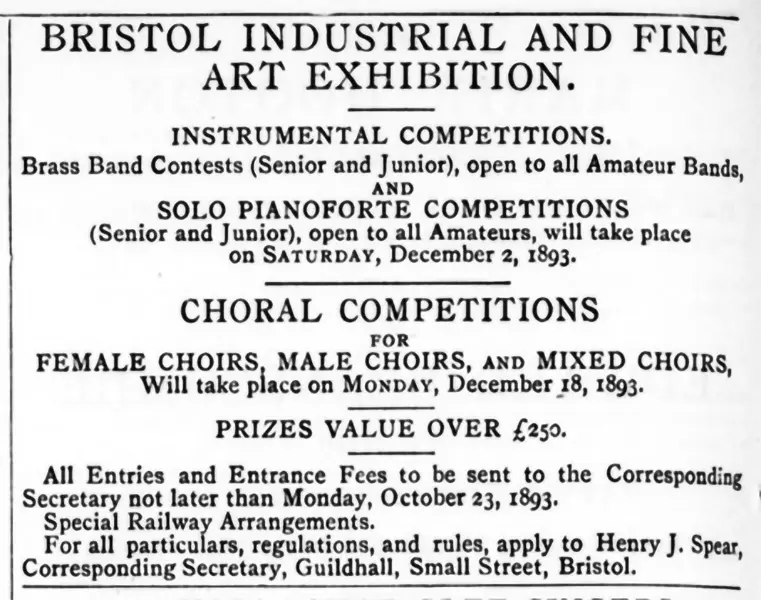
The Musical Times, October 1, 1893
Souvenirs
As would happen today, visitors could buy a selection of glasses, coins, pamphlets and other souvenirs.
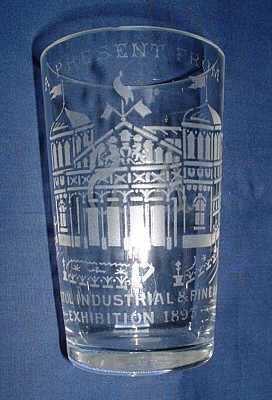
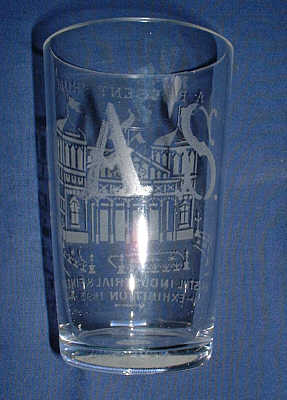
Glasses commemorating the 1893 Bristol Industrial and Fine Arts Exhibition
Photos by kind courtesy of Allan Wathan
Medals and medallions were also for purchase. Such as this 1.5" (38mm) one. It was made of pewter; the obverse showed a representation of the exhibition building and the reverse had Bristol Industrial and Fine Arts Exhibition 1893 stamped on it above a spray of oak leaves.
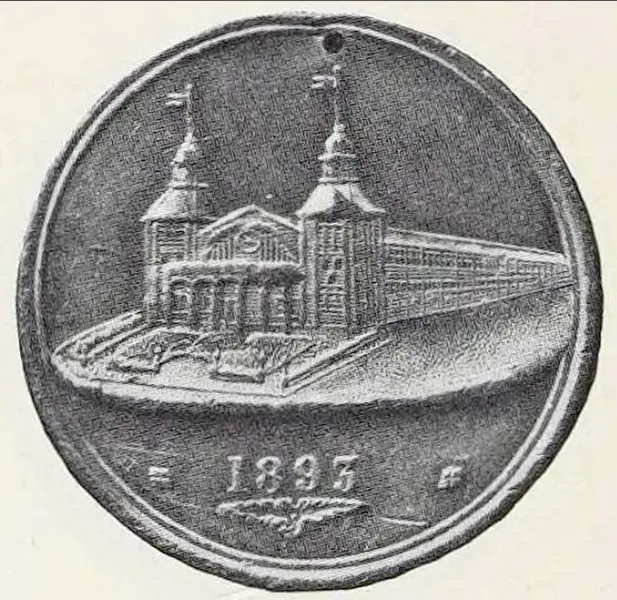
Exhibition medal
Image from The Architectural Medal : England in the Nineteenth Century (Internet Archive) by Jeremy Taylor and Reginald Buckley.
Sources & Resources
It appears not much has been written about the Bristol 1983 Industrial & Fine Arts Exhibition. Luckily, historians and photgraphers such as Fred Little and John Latimer did record at least some of the exhibition.
Annals of Bristol 1887-1900 by John Latimer. Published by Wiliam George's Sons, Bristol, 1902
Beatrice Pettit (1872-1922) - A Cornet Soloist
Bristol Archives Catalogue - Photos of the Bristol Industrial and Fine Art Exhibition exterior
Bristol as it was 1845-1900 by Reece Winstone. First edition, published in 1983
Bristol in the 1890's by Reece Winstone. Third edition, published in 1973
Engineering : An Illustrated Weekly Journal (Internet Archive), 1884. This is interesting because it covers an earlier Bristol industrial exhibition
Frost & Reed - Art Biographies
List of Public Art in Bristol - Wikipedia
The Architectural Medal : England in the Nineteenth Century (Internet Archive) by Jeremy Taylor and Reginald Buckley. British Museum Publications, 1978
The Bristol Industrial and Fine Art Exhibition, 1893 : Fine Art Section. Exhibit IV. Dr. Edward Jenner M.D., F.R.S.
The Musical Times of October 1, 1893 (Internet Archive) - Volume 34, Issue 608
The World's Paper Trade Review (Internet Archive) - July-December, 1893. Volume 20
